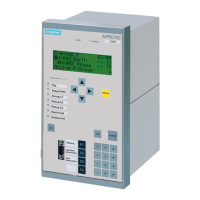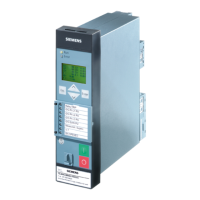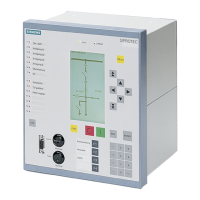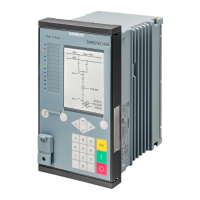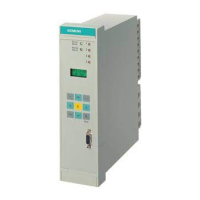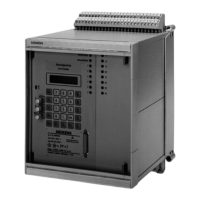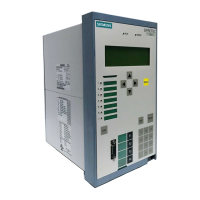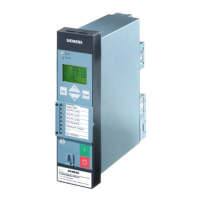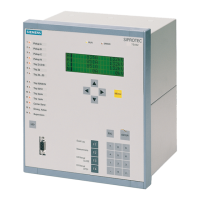2 Functions
142
7SD610 Manual
C53000-G1176-C145-4
The adaptive dead time may be voltage-controlled or Remote–CLOSE–controlled.
Both are possible at the same time. In the first case, reclosure takes place as soon as
the returning voltage, after reclosure at the remote end, is detected. For this purpose
the device must be connected to voltage transformers located on the line side. In the
case of Remote-CLOSE, the autoreclosure waits until the Remote-CLOSE command
is received from the remote end.
The action time T-ACTION ADT (address 3433) is the timeframe after initiation (fault
detection) by any protective function which can start the automatic reclosure function
within which the trip command must appear. If no trip command is issued until the
action time has expired, there is no reclosure. Depending on the configuration of the
protective functions (see Section 2.1.1.2), the action time may also be omitted; this
applies especially when an initiating protective function has no fault detection signal.
The dead times are determined by the reclosure command of the device at the line
end with the defined dead times. In cases where this reclosure command does not
appear, e.g. because the reclosure was in the meantime blocked at this end, the readi-
ness of the local device must return to the quiescent state at some time. This takes
place after the maximum wait time T-MAX ADT (address 3434). This must be long
enough to include the last reclosure of the remote end. In the case of single cycle re-
closure, the sum total of maximum dead time plus reclaim time of the other device is
sufficient. In the case of multiple reclosure the worst case is that all reclosures of the
other end except the last one are unsuccessful. The time of all these cycles must be
taken into account. To save having to make exact calculations, it is possible to use the
sum of all dead times and all protection operating times plus one reclaim time.
At address 3435 ADT 1p allowed it can be determined whether single-pole tripping
is allowed (provided that single-pole tripping is possible). If NO, the protection trips
three-pole for all fault types. If YES, the actual trip signal of the starting protective func-
tions is decisive. If the blocking time is unequal to 0 s and single-pole tripping is al-
lowed, single-pole tripping will be prevented during the blocking time. Each fault is
thus disconnected in three poles while the blocking time expires.
Address 3403 T-RECLAIM allows disabling the blocking time in ADT mode. In doing
so, the ADT cycle including its settings and release conditions is restarted after unsuc-
cessful automatic reclosing. If the blocking time is activated, the single-pole permis-
sion at address 3435 and the protection releases are disabled while the blocking time
expires.
Under address 3436 ADT CB? CLOSE it can be determined whether circuit breaker
ready is interrogated before reclosure after an adaptive dead time. With the setting
YES, the dead time may be extended if the circuit breaker is not ready for a CLOSE–
OPEN–cycle when the dead time expires. The maximum extension that is possible is
the circuit breaker monitoring time; this was set for all reclosure cycles under address
3409 (see above). Details about the circuit breaker monitoring can be found in the
function description, Section 2.10, at margin heading „Interrogation of the Circuit
Breaker Ready State“.
If there is a danger of stability problems in the network during a three-pole reclosure
cycle, set address 3437 ADT SynRequest to YES. In this case a check is made
before reclosure following a three-pole trip whether the voltages of feeder and busbar
are sufficiently synchronous. This is only done on condition that either the internal syn-
chronism and voltage check functions are available, or that an external device is avail-
able for synchronism and voltage check. If only single-pole reclose cycles are execut-
ed or if no stability problems are expected during three-pole dead times (e.g. due to
closely meshed networks or in radial networks), set address 3437 to NO.
Addresses 3438 and 3440 are only significant if the voltage-controlled adaptive dead
time is used. 3440 U-live> is the phase-earth voltage limit above which the line is
www . ElectricalPartManuals . com
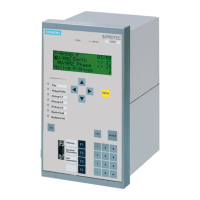
